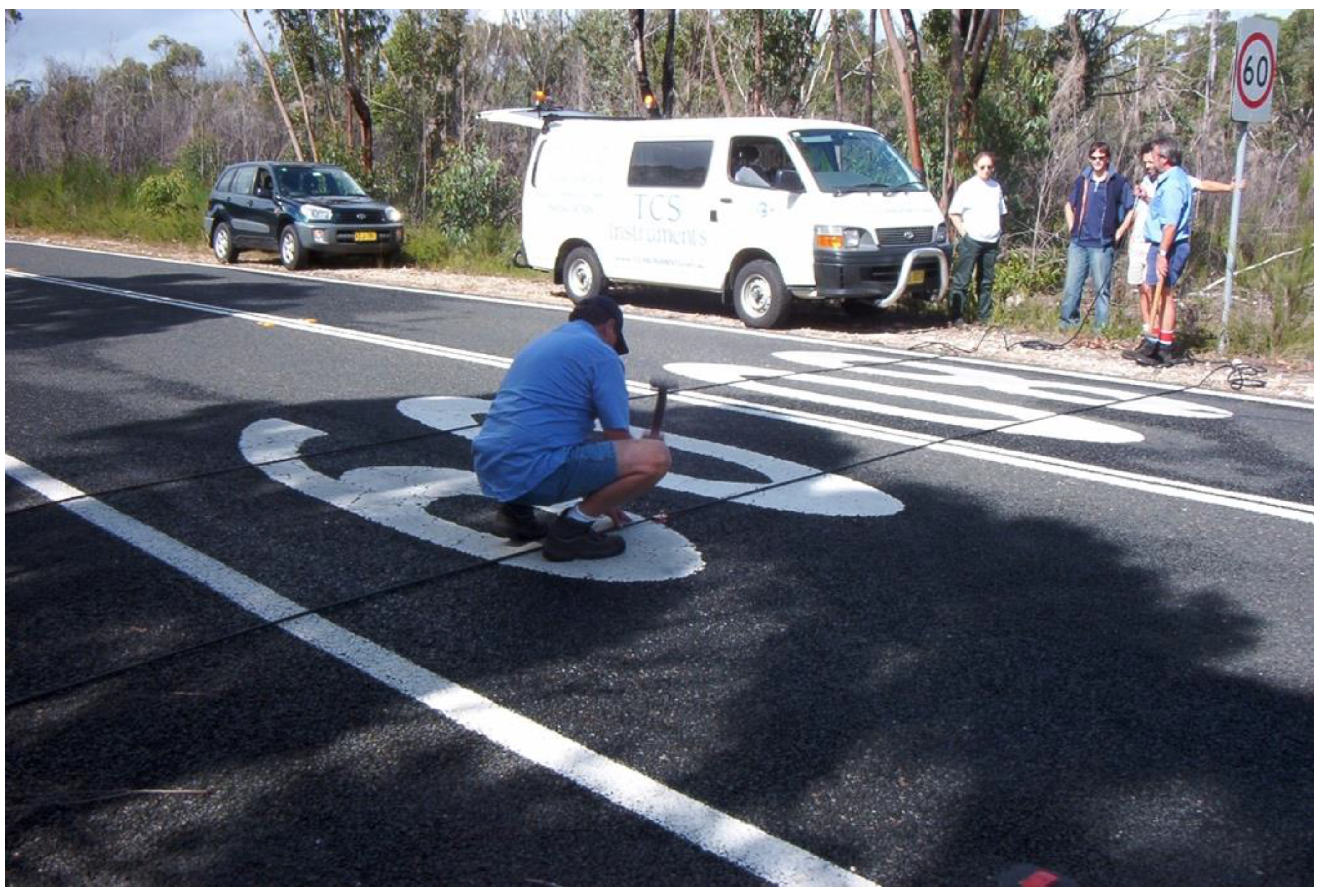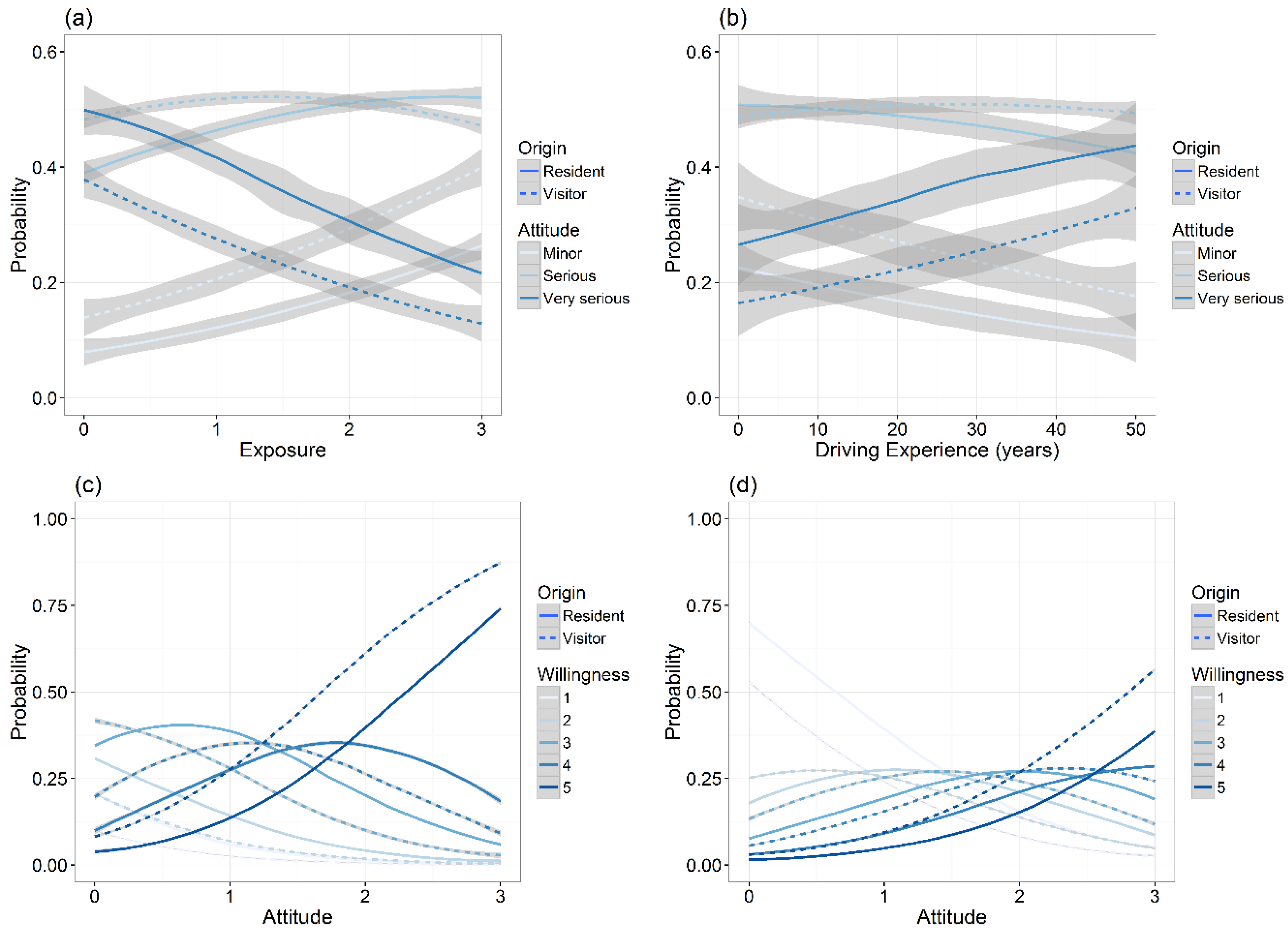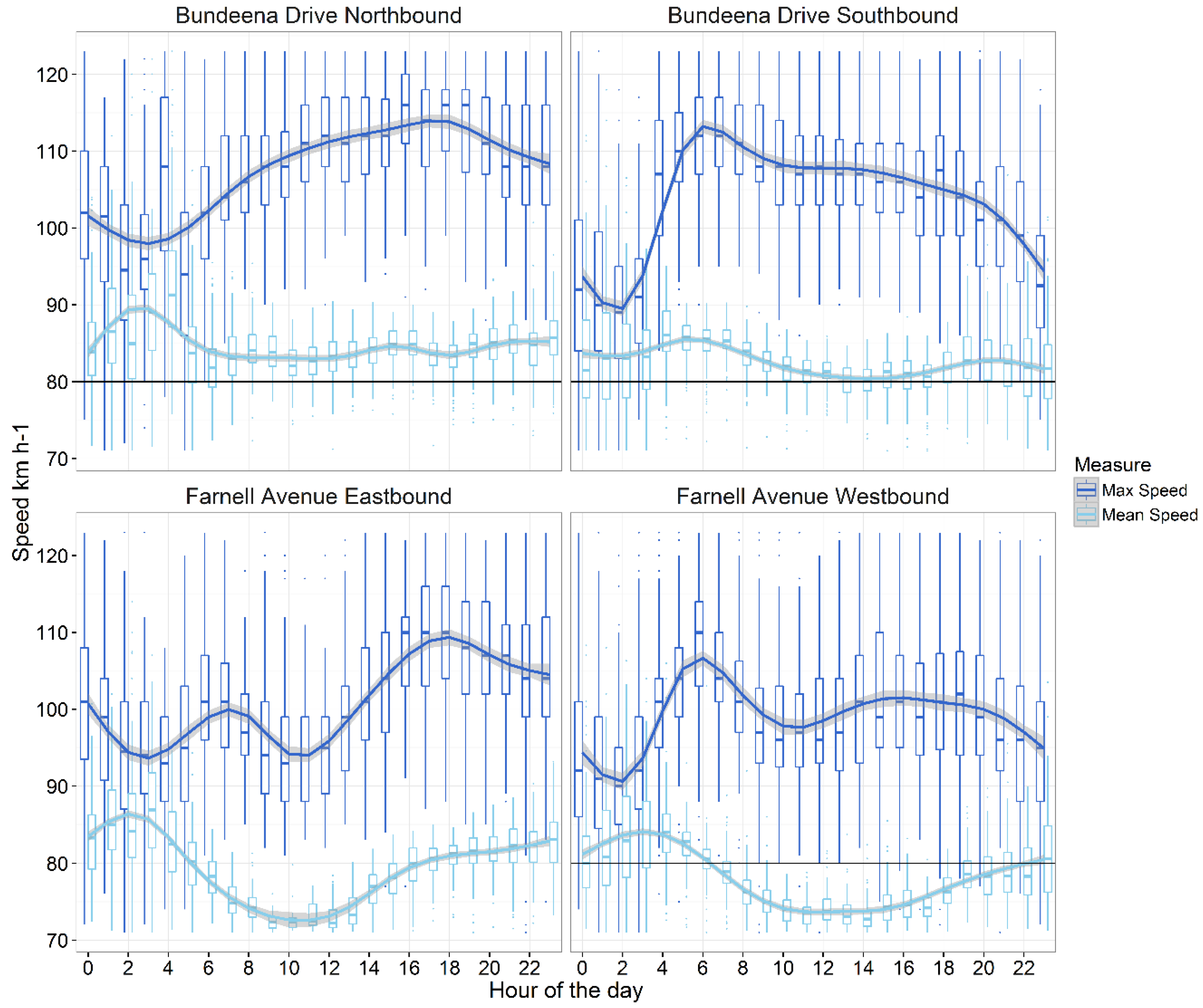Contradiction and Complacency Shape Attitudes towards the Toll of Roads on Wildlife
Abstract
:Simple Summary
Abstract
1. Introduction
2. Materials and Methods
2.1. Study Location
2.2. Driver Questionnaire
2.3. Subjects
2.4. Driver Demography
2.5. Driver Speed
2.6. Statistical Analysis
3. Results
3.1. Driver Experience with WVC
3.2. Driver Behaviour to Mitigate WVC
3.3. Driver Attitudes to Mitigating WVC
3.4. Driver Speeds and WVC Risk
4. Discussion
5. Conclusions
Acknowledgments
Author Contributions
Conflicts of Interest
Abbreviations
| WVC | Wildlife-vehicle collision |
| DOAJ | Directory of open access journals |
Appendix A
- Are you a visitor or local resident?
- What is your age?
- ≤20 years, 20–29 years, 30–39 years, 40–49 years, 50–59 years, ≥60 years.
- What kind of vehicle(s) do you normally drive?
- 4-wheel drive or people mover, family sedan, utility or small van, motorcycle, sports car, articulated truck, light truck, bus, heavy rigid truck, other.
- How many years have you been driving for?
- <1 year, 1–3 years, 4–9 years, 10–19 years, 20–29 years, 30–39 years, 40–49 years, ≥50 years.
- In the time you have been driving, around how many animals have you hit?
- None, none hit but some near misses, 1–10, More than 10.
- Of those animals you have hit (or nearly hit), what proportion were native Australian animals?
- In most cases, if you saw the animal before hitting it, what did you do?
- Swerved, braked, accelerated, took no action.
- If you took avoidance actions what did this depend on?
- The size of the animal, the type of animal (reptile, bird, mammal), the status of the animal (native or introduced).
- What circumstances would cause you to check on the welfare of the animal (regardless of who hit it)?
- None, the animal was still visible from the road, I had free time, I thought it had a chance for survival, I thought it might have pouch young.
- If you did check on the welfare of the animal, what did this depend on?
- The size of the animal, the type of animal (reptile, bird, mammal, etc.), the status of the animal (native or introduced).
- Do you currently do anything to minimise your chances of hitting or killing an animal?
- Travel slower where there are animals around (e.g., in signposted wildlife zones), attach wildlife deterrents (such as whistles) to your car, carry provisions in your vehicle to help injured wildlife (e.g., gloves, blanket), keep the phone numbers of wildlife rescue organisations (e.g., WIRES) with you, other.
- What damage has your vehicle ever sustained in a collision (or near collision) with an animal?
- Minor damage, substantial damage (e.g., insurance claim), vehicle unrepairable, persons injured.
- How do you feel about the issue of road-kill?
- It is a very serious problem, it is a serious problem, it is a minor problem, no problem at all, indifferent.
- On a scale of 1–5, how willing would you be to take the following actions to minimise road-kill (1 = totally against it, 2 = unwilling, 3 = hesitant, 4 = willing, 5 = happy to)?
- Drive slower, reduce speed in wildlife crossing zones, reduce amount of time driving at dusk and dawn, reduce speed at dusk and dawn, use a wildlife deterrent for your car that is cheap and proven to be effective.
Appendix B
| Question | Category | Origin | Age | Animals Hit | |||||||
|---|---|---|---|---|---|---|---|---|---|---|---|
| Resident (105) | Visitor (51) | <30 (24) | 30–59 (111) | >59 (18) | None (42) | Near Miss * (34) | 1–10 (76) | >10 (3) | Total (156) | ||
| Vehicle type [3] | 4WD | 0.24 | 0.25 | 0.13 | 0.23 | 0.44 | 0.14 | 0.38 | 0.24 | 0.33 | 0.24 |
| Ute/Van | 0.06 | 0.10 | 0.08 | 0.06 | 0.06 | 0.02 | 0.03 | 0.11 | 0.33 | 0.07 | |
| Art. Truck | 0.00 | 0.00 | 0.00 | 0.00 | 0.00 | 0.00 | 0.00 | 0.00 | 0.00 | 0.00 | |
| HR Truck | 0.01 | 0.00 | 0.00 | 0.01 | 0.00 | 0.00 | 0.03 | 0.00 | 0.00 | 0.01 | |
| Sedan | 0.53 | 0.57 | 0.58 | 0.58 | 0.39 | 0.62 | 0.56 | 0.51 | 0.00 | 0.54 | |
| Motorbike | 0.03 | 0.02 | 0.04 | 0.02 | 0.06 | 0.00 | 0.03 | 0.03 | 0.33 | 0.03 | |
| Light Truck | 0.02 | 0.00 | 0.00 | 0.02 | 0.00 | 0.05 | 0.00 | 0.00 | 0.00 | 0.01 | |
| Compact | 0.08 | 0.08 | 0.17 | 0.06 | 0.06 | 0.10 | 0.00 | 0.11 | 0.00 | 0.08 | |
| Sports | 0.03 | 0.02 | 0.08 | 0.02 | 0.00 | 0.05 | 0.06 | 0.00 | 0.00 | 0.03 | |
| Bus | 0.00 | 0.00 | 0.00 | 0.00 | 0.00 | 0.00 | 0.00 | 0.00 | 0.00 | 0.00 | |
| Other | 0.08 | 0.04 | 0.08 | 0.05 | 0.06 | 0.02 | 0.00 | 0.11 | 0.33 | 0.06 | |
| Damage sustained in animal collision [12] | Minor | 0.33 | 0.27 | 0.46 | 0.30 | 0.28 | 0.12 | 0.18 | 0.47 | 0.67 | 0.31 |
| Substantial | 0.19 | 0.06 | 0.08 | 0.15 | 0.17 | 0.00 | 0.09 | 0.24 | 0.67 | 0.15 | |
| Total (write-off) | 0.02 | 0.02 | 0.00 | 0.02 | 0.06 | 0.00 | 0.03 | 0.03 | 0.00 | 0.02 | |
| Persons injured | 0.04 | 0.02 | 0.04 | 0.04 | 0.00 | 0.00 | 0.06 | 0.04 | 0.00 | 0.03 | |
| Reaction to animal on road [7] | Swerved | 0.52 | 0.43 | 0.54 | 0.49 | 0.50 | 0.52 | 0.41 | 0.50 | 1.00 | 0.49 |
| Braked | 0.79 | 0.76 | 0.58 | 0.81 | 0.83 | 0.81 | 0.91 | 0.70 | 1.00 | 0.78 | |
| Accelerated | 0.01 | 0.02 | 0.00 | 0.02 | 0.00 | 0.00 | 0.00 | 0.03 | 0.00 | 0.01 | |
| No action | 0.06 | 0.04 | 0.04 | 0.05 | 0.06 | 0.00 | 0.03 | 0.09 | 0.00 | 0.05 | |
| Animal avoidance criteria [8] | Size | 0.42 | 0.51 | 0.58 | 0.42 | 0.44 | 0.48 | 0.56 | 0.38 | 0.67 | 0.45 |
| Type | 0.27 | 0.25 | 0.25 | 0.26 | 0.28 | 0.21 | 0.29 | 0.28 | 0.33 | 0.26 | |
| Status | 0.25 | 0.22 | 0.21 | 0.23 | 0.28 | 0.19 | 0.26 | 0.24 | 0.33 | 0.24 | |
| Situation criteria for stopping to check on animal [9] | Would not check | 0.02 | 0.04 | 0.04 | 0.02 | 0.06 | 0.05 | 0.00 | 0.03 | 0.00 | 0.03 |
| Visible from road | 0.43 | 0.49 | 0.46 | 0.43 | 0.56 | 0.40 | 0.44 | 0.46 | 1.00 | 0.45 | |
| Spare time | 0.10 | 0.08 | 0.17 | 0.09 | 0.00 | 0.02 | 0.12 | 0.12 | 0.00 | 0.09 | |
| Chance for survival | 0.67 | 0.69 | 0.67 | 0.70 | 0.44 | 0.64 | 0.65 | 0.68 | 1.00 | 0.67 | |
| May have pouch young | 0.48 | 0.43 | 0.46 | 0.46 | 0.44 | 0.40 | 0.53 | 0.45 | 1.00 | 0.46 | |
| Animal criteria for checking welfare [10] | Size | 0.22 | 0.25 | 0.25 | 0.23 | 0.28 | 0.24 | 0.26 | 0.22 | 0.00 | 0.23 |
| Type | 0.39 | 0.43 | 0.54 | 0.41 | 0.22 | 0.31 | 0.41 | 0.45 | 0.67 | 0.40 | |
| Status | 0.31 | 0.31 | 0.42 | 0.26 | 0.50 | 0.29 | 0.38 | 0.29 | 0.33 | 0.31 | |
| Current mitigation measures [11] | Drive slower in wildlife zones | 0.79 | 0.92 | 0.63 | 0.88 | 0.78 | 0.88 | 0.85 | 0.80 | 0.67 | 0.83 |
| Use deterrent | 0.10 | 0.04 | 0.04 | 0.05 | 0.28 | 0.02 | 0.12 | 0.09 | 0.00 | 0.08 | |
| Carry provisions to help animal | 0.17 | 0.08 | 0.17 | 0.14 | 0.11 | 0.14 | 0.15 | 0.14 | 0.00 | 0.14 | |
| Carry wildlife rescue phone no. | 0.27 | 0.25 | 0.25 | 0.27 | 0.22 | 0.31 | 0.24 | 0.22 | 0.67 | 0.26 | |
| Other | 0.21 | 0.06 | 0.29 | 0.14 | 0.06 | 0.17 | 0.12 | 0.18 | 0.00 | 0.16 | |
| Willingness to undertake mitigation ** [14] | Drive slower | 4.2 | 4.5 | 4.2 | 4.3 | 4.5 | 4.6 | 4.4 | 4.1 | 3.5 | 4.3 |
| Drive slower in wildlife zones | 4.5 | 4.7 | 4.4 | 4.6 | 4.7 | 4.8 | 4.6 | 4.4 | 4.0 | 4.5 | |
| Drive less at dawn & dusk | 3.2 | 3.6 | 3.3 | 3.4 | 3.8 | 3.4 | 3.6 | 3.2 | 2.0 | 3.3 | |
| Drive slower at dawn & dusk | 4.1 | 4.5 | 4.1 | 4.3 | 4.3 | 4.4 | 4.3 | 4.1 | 3.3 | 4.2 | |
| Use deterrent | 4.4 | 4.3 | 4.5 | 4.5 | 4.6 | 4.3 | 4.6 | 4.3 | 4.7 | 4.4 | |
References
- Lowry, H.; Lill, A.; Wong, B. Behavioural responses of wildlife to urban environments. Biol. Rev. 2013, 88, 537–549. [Google Scholar] [CrossRef] [PubMed]
- Simaika, J.P.; Samways, M.J. Biophilia as a universal ethic for conserving biodiversity. Conserv. Biol. 2010, 24, 903–906. [Google Scholar] [CrossRef] [PubMed]
- Ramp, D.; Bekoff, M. Compassion as a practical and evolved ethic for conservation. BioScience 2015, 65, 323–327. [Google Scholar] [CrossRef]
- Fraser, D.; MacRae, A.M. Four types of activities that affect animals: implications for animal welfare science and animal ethics philosophy. Anim. Welf. 2011, 20, 581–590. [Google Scholar]
- Forman, R.T.T. Road ecology: A solution for the giant embracing us. Landsc. Ecol. 1998, 13. [Google Scholar] [CrossRef]
- Jones, D.; Bekker, H.; van de Ree, R. Road ecology in an urbanising world. In Handbook of Road Ecology; van de Ree, R., Smith, D.J., Grilo, C., Eds.; John Wiley & Sons Ltd.: London, UK, 2015; pp. 391–396. [Google Scholar]
- Mastro, L.L.; Conover, M.R.; Frey, S.N. Deer-vehicle collision prevention techniques. Hum.-Wildl. Confl. 2008, 2, 80–92. [Google Scholar]
- Roger, E.; Ramp, D. Incorporating habitat use in models of fauna fatalities on roads. Divers. Distrib. 2009, 15, 222–231. [Google Scholar] [CrossRef]
- Neumann, W.; Ericsson, G.; Dettki, H.; Bunnefeld, N.; Keuler, N.S.; Helmers, D.P.; Radeloff, V.C. Difference in spatiotemporal patterns of wildlife road-crossings and wildlife-vehicle collisions. Biol. Conserv. 2012, 145, 70–78. [Google Scholar] [CrossRef]
- Putman, R.J. Deer and road traffic accidents: Options for management. J. Environ. Manag. 1997, 51, 43–57. [Google Scholar] [CrossRef]
- Haikonen, H.; Summala, H. Deer-vehicle crashes—Extensive peak at 1 hour after sunset. Am. J. Prev. Med. 2001, 21, 209–213. [Google Scholar] [CrossRef]
- Pojar, T.M.; Prosence, R.A.; Reed, D.F.; Woodard, T.N. Effectiveness of a lighted, animated deer crossing sign. J. Wildl. Manag. 1975, 39, 87–91. [Google Scholar] [CrossRef]
- Sullivan, T.L.; Williams, A.E.; Messmer, T.A.; Hellinga, L.A.; Kyrychenko, S.Y. Effectiveness of temporary warning signs in reducing deer-vehicle collisions during mule deer migrations. Wildl. Soc. Bull. 2004, 32, 907–915. [Google Scholar] [CrossRef]
- Gordon, K.M.; McKinstry, M.C.; Anderson, S.H. Motorist response to a deer-sensing warning system. Wildl. Soc. Bull. 2004, 32, 565–573. [Google Scholar] [CrossRef]
- Huijser, M.P.; Mosler-Berger, C.; Olsson, M.; Strein, M. Wildlife warning signs and animal detection systems aimed at reducing wildlife-vehicle collisions. In Handbook of Road Ecology; Van de Ree, R., Smith, D.J., Grilo, C., Eds.; John Wiley & Sons Ltd.: London, UK, 2015; pp. 198–212. [Google Scholar]
- Khattak, A.J. Human fatalities in animal-related highway crashes. In Statistical Methods and Modeling and Safety Data, Analysis, and Evaluation; Transportation Research Board, National Academy of Sciences: Washington, DC, USA, 2003; pp. 158–166. [Google Scholar]
- Groot Brunderink, G.W.T.A.; Hazebroek, E. Ungulate traffic collisions in Europe. Biol. Conserv. 1996, 99, 331–340. [Google Scholar] [CrossRef]
- Lee, E.; Croft, D.B.; Ramp, D. Flight response as a causitive factor in kangaroo-vehicle collisions. In Macropods: The Biology of Kangaroos, Wallabies and Rat-kangaroos; Coulson, G., Eldridge, M.D.B., Eds.; CSIRO Publishing: Melbourne, Australia, 2010; pp. 301–312. [Google Scholar]
- Jones, M.E. Road upgrade, road mortality and remedial measures: Impacts on a population of eastern quolls and Tasmanian devils. Wildl. Res. 2000, 27, 289–296. [Google Scholar] [CrossRef]
- Rumar, K. The role of perceptual and cognitive filters in observed behaviour. In Human Behaviour and Traffic Safety; Evans, L., Schwing, R.C., Eds.; Plenum Press: New York, NY, USA, 1985; pp. 151–165. [Google Scholar]
- Åberg, L.; Rimmö, P.A. Dimensions of aberrant driver behaviour. Ergonomics 1998, 41, 39–56. [Google Scholar] [CrossRef] [PubMed]
- Ozkan, T.; Lajunen, T.; Summala, H. Driver behaviour questionnaire: A follow-up study. Accid. Anal. Prev. 2006, 38, 386–395. [Google Scholar] [CrossRef] [PubMed]
- Reason, J.; Stradling, S.; Baxter, J.; Campbell, K. Errors and violations on the roads: A real distinction? Ergonomics 1990, 33, 1315–1332. [Google Scholar] [CrossRef] [PubMed]
- Winter, J.C.F.; Dodou, D. The driver behaviour questionnaire as a predictor of accidents: A meta-analysis. J. Saf. Res. 2010, 41, 463–470. [Google Scholar] [CrossRef] [PubMed]
- Elvik, R. Some implications of an event-based definition of exposure to the risk of road accident. Accid. Anal. Prev. 2015, 76, 15–24. [Google Scholar] [CrossRef] [PubMed]
- Ramp, D.; Wilson, V.K.; Croft, D.B. Assessing the impacts of roads in peri-urban reserves: Road-based fatalities and road usage by wildlife in the Royal National Park, New South Wales, Australia. Biol. Conserv. 2006, 129, 348–359. [Google Scholar] [CrossRef]
- New South Wales National Parks and Wildlife Service. Royal National Park, Heathcote National Park and Garawarra Recreation Area Plan of Management; New South Wales National Parks and Wildlife Service: Sydney, Australia, 2000. [Google Scholar]
- R Core Team. R: A Language Environment for Statistical Computing; R Foundation for Statistical Computing: Vienna, Austria, 2016; Available online: https://www.r-project.org/ (accessed on 1 March 2016).
- Blockey, P.N.; Hastley, L.R. Aberrant driving behaviour: Errors and violations. Ergonomics 1995, 38, 1759–1771. [Google Scholar] [CrossRef] [PubMed]
- Beckmann, C.; Shine, R. Do drivers intentionally target wildlife on roads? Austral Ecol. 2012, 37, 629–632. [Google Scholar] [CrossRef]
- Ben-Ami, D.; Ramp, D. Impact of roadside habitat on swamp wallaby movement and fitness. Wildlife. Res. 2013, 40, 512–522. [Google Scholar] [CrossRef]
- Weinstein, N.D. Effects of personal experience on self-reported behaviour. Psychol. Bull. 1989, 105, 31–50. [Google Scholar] [CrossRef] [PubMed]
- Ramp, D. Roads as drivers of change for macropodids. In Macropods: The Biology of Kangaroos, Wallabies and Rat-Kangaroos; Coulson, G., Eldridge, M.D.B., Eds.; CSIRO Publishing: Melbourne, Australia, 2010; pp. 279–291. [Google Scholar]
- Ramp, D.; Roger, E. Frequency of animal-vehicle collisions in NSW. In Too Close for Comfort: Contentious Issues in Human-Wildlife Encounters; Lunney, D., Munn, A., Meikle, W., Eds.; Royal Zoological Society of New South Wales: Mosman, Australia, 2008; pp. 118–126. [Google Scholar]





| Model | Variable | Value | SE | t Value | p Value | Odds Ratio |
|---|---|---|---|---|---|---|
| Attitude | Exposure | −0.479 | 0.224 | −2.141 | 0.032 * | 0.619 |
| Visitor | −0.631 | 0.341 | −1.851 | 0.064 | 0.532 | |
| Experience | 0.019 | 0.012 | 1.523 | 0.127 | 1.019 | |
| Drive slower | Attitude | 1.433 | 0.283 | 5.069 | >0.001 * | 4.191 |
| Exposure | −0.419 | 0.239 | −1.754 | 0.079 | −0.268 | |
| Visitor | 0.883 | 0.389 | 2.268 | 0.023 * | 0.711 | |
| Experience | −0.007 | 0.013 | −0.491 | 0.623 | 0.001 | |
| Avoid dawn/dusk | Attitude | 1.256 | 0.248 | 5.059 | >0.001 * | 3.512 |
| Exposure | −0.268 | 0.223 | −1.203 | 0.229 | 0.765 | |
| Visitor | 0.711 | 0.333 | 2.135 | 0.033 * | 2.036 | |
| Experience | 0.001 | 0.012 | 0.033 | 0.973 | 1.001 |
© 2016 by the authors; licensee MDPI, Basel, Switzerland. This article is an open access article distributed under the terms and conditions of the Creative Commons Attribution (CC-BY) license (http://creativecommons.org/licenses/by/4.0/).
Share and Cite
Ramp, D.; Wilson, V.K.; Croft, D.B. Contradiction and Complacency Shape Attitudes towards the Toll of Roads on Wildlife. Animals 2016, 6, 40. https://doi.org/10.3390/ani6060040
Ramp D, Wilson VK, Croft DB. Contradiction and Complacency Shape Attitudes towards the Toll of Roads on Wildlife. Animals. 2016; 6(6):40. https://doi.org/10.3390/ani6060040
Chicago/Turabian StyleRamp, Daniel, Vanessa K. Wilson, and David B. Croft. 2016. "Contradiction and Complacency Shape Attitudes towards the Toll of Roads on Wildlife" Animals 6, no. 6: 40. https://doi.org/10.3390/ani6060040
APA StyleRamp, D., Wilson, V. K., & Croft, D. B. (2016). Contradiction and Complacency Shape Attitudes towards the Toll of Roads on Wildlife. Animals, 6(6), 40. https://doi.org/10.3390/ani6060040







